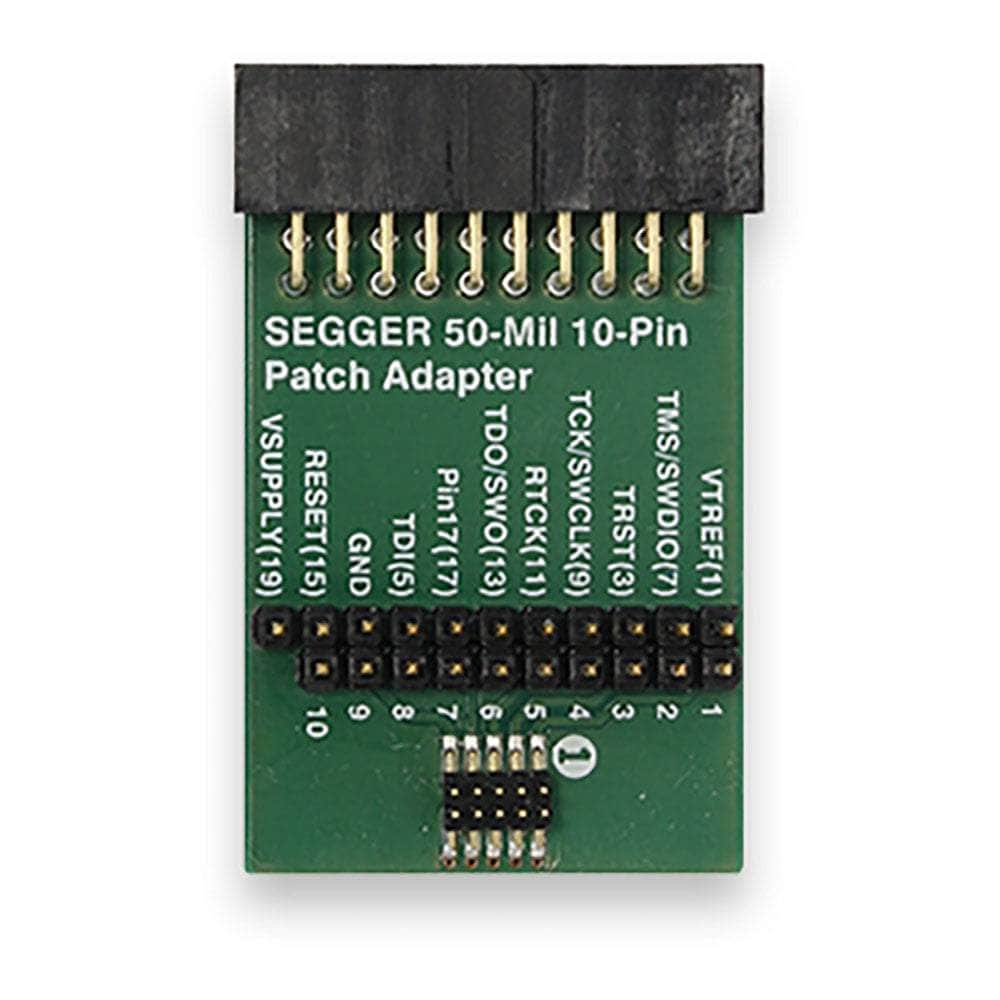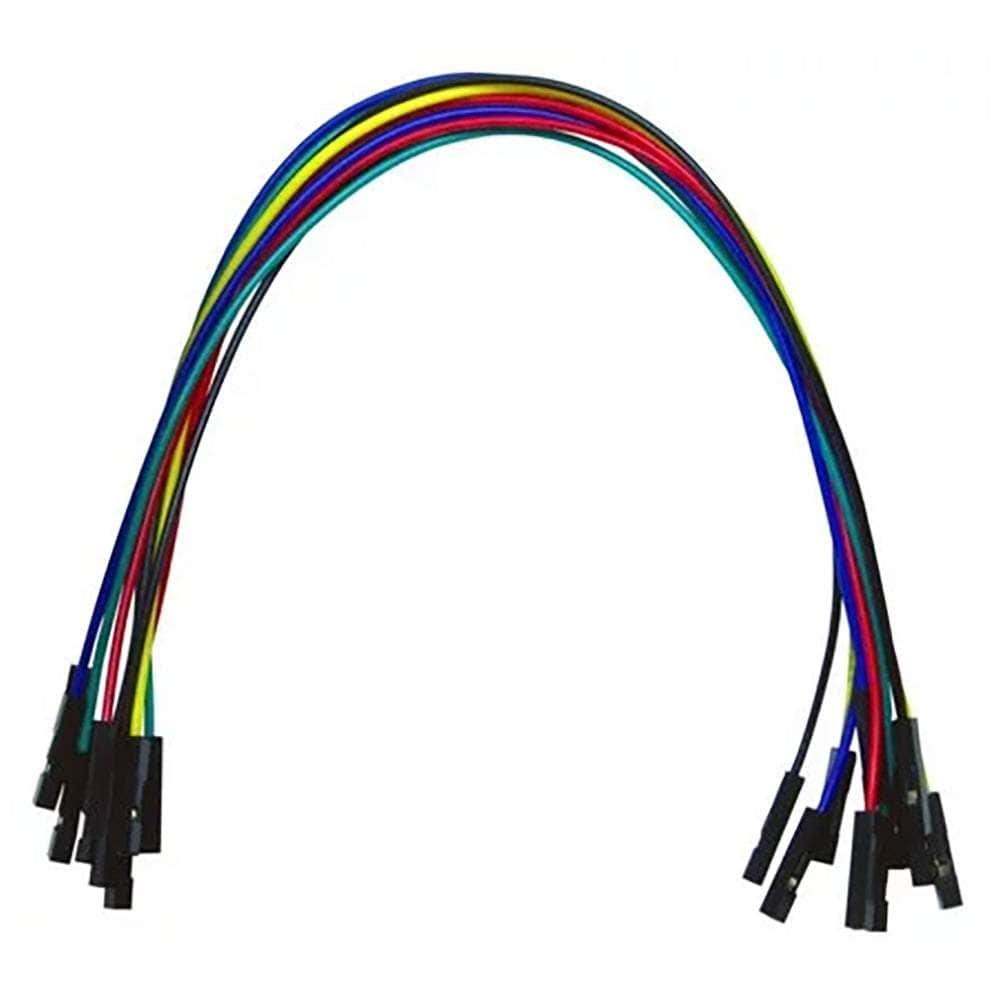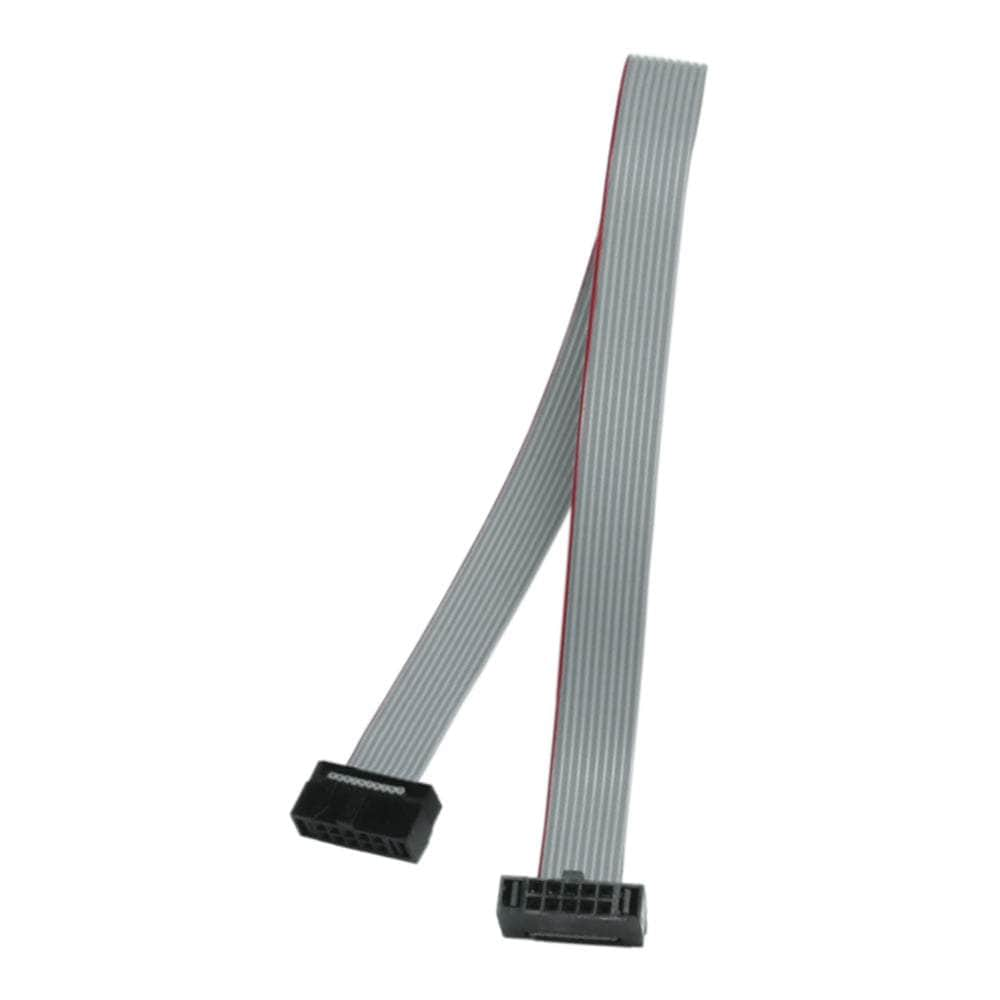


Key Features
Overview
Downloads
Why Engineers Choose The SEGGER 0.1" To 50-mil 10-Pin Patch Adapter
Space Optimisation
Legacy Support
Cost Efficiency
Technical Overview
The SEGGER 50-Mil 10-Pin Patch Adapter bridges the gap between traditional 20-pin JTAG interfaces and modern compact 10-pin Cortex-M connectors. This professional-grade adapter serves dual purposes: standard Cortex-M connectivity and custom pin mapping for legacy or proprietary designs.
Connector Specifications
| Side | Connector Type | Pin Count | Pitch | Compatible With |
|---|---|---|---|---|
| Input | 20-pin IDC Socket | 20 | 0.1" (2.54mm) | Standard JTAG debuggers |
| Output | 10-pin Header | 10 | 0.05" (1.27mm) | ARM Cortex-M targets |
Standard Cortex-M Pinout
When used with the included ribbon cable, the adapter follows ARM's standard 10-pin Cortex-M debug connector specification:
| Pin | Signal | Pin | Signal |
|---|---|---|---|
| 1 | VTref | 2 | SWDIO/TMS |
| 3 | GND | 4 | SWCLK/TCK |
| 5 | GND | 6 | SWO/TDO |
| 7 | KEY (No pin) | 8 | NC/TDI |
| 9 | GND | 10 | nRESET |
Custom Wiring Quick-Start
For non-standard pinouts, replace the ribbon cable with individual jumper wires:
- Disconnect the ribbon cable from the 10-pin header side
- Identify target pinout from your PCB documentation
- Connect jumper wires between 20-pin test points and 10-pin header pins
- Verify connections with multimeter before powering target
Compatible Debug Probes
This adapter works with any debug probe featuring a standard 20-pin 0.1" JTAG connector:
- SEGGER: J-Link BASE, PLUS, PRO, ULTRA+, WiFi, Flasher series
- STMicroelectronics: ST-LINK/V2, ST-LINK/V3SET
- P&E Micro: Multilink Universal, Cyclone ARM
- ARM: ULINK2, ULINKplus (with adapter)
PCB Layout Considerations
When designing PCBs for 10-pin debug connectors:
| Parameter | Recommendation | Notes |
|---|---|---|
| Connector Type | Samtec FTSH-105-01-L-DV | Shrouded, surface mount |
| Keep-out Zone | 3mm all sides | For connector and cable clearance |
| Via Size | 0.2mm drill min | Standard PCB manufacturing |
| Trace Width | 0.1mm minimum | For high-speed signals |
Signal Integrity Guidelines
For reliable high-speed debugging:
- Cable Length: Keep total cable length under 30cm
- Ground Planes: Use solid ground planes under debug traces
- Impedance: Match 50Ω characteristic impedance for clock signals
- Termination: Add series termination resistors if signal integrity issues occur
Troubleshooting Common Issues
| Symptom | Possible Cause | Solution |
|---|---|---|
| No target detection | VTref not connected | Verify pin 1 connection to target VCC |
| Intermittent connection | Poor jumper wire contact | Check all jumper wire connections |
| High-speed programming fails | Cable too long | Reduce total cable length |
| Cannot reset target | nRESET not connected | Connect pin 10 to target reset |
Application Examples
Space-Constrained IoT Devices
Modern IoT devices often cannot accommodate 20-pin connectors. This adapter enables the use of compact 10-pin connectors while maintaining compatibility with existing JTAG tools.
Legacy System Integration
When working with older designs that use non-standard debug pinouts, the custom wiring capability allows connection without PCB modifications.
Production Programming
In manufacturing environments, the compact connector reduces fixture complexity while maintaining programming speed and reliability.
| General Information | |
|---|---|
Product Type |
Adapter
|
Part Number (SKU) |
8.06.28
|
Manufacturer |
|
| Physical and Mechanical | |
Weight |
0.02 kg
|
| Other | |
Warranty |
|
HS Code Customs Tariff code
|
|
EAN |
5055383614400
|
Frequently Asked Questions
Have a Question?
-
How does this compare to Tag-Connect solutions for space-saving
While Tag-Connect eliminates connectors entirely using spring pins, this adapter provides a more permanent connection solution with standard connectors that many engineers prefer for reliability.
-
What connectors are compatible on the target side?
The 10-pin side uses standard 0.05" (1.27mm) pitch connectors. Compatible target connectors include Samtec FTSH series and equivalent 2x5 0.05" shrouded headers.
-
Does this work with automotive-grade debugging applications?
Yes, the adapter meets professional standards for automotive and industrial applications. It's commonly used in ECU programming and embedded automotive development workflows.
-
Can this adapter handle 3.3V and 5V target voltages?
The adapter is voltage-transparent and works with any target voltage supported by your debug probe. Most modern applications use 3.3V, but 1.8V and 5V targets are also supported.
-
What's the maximum cable length I can use with this adapter?
The included ribbon cable is optimised for signal integrity. For longer connections, keep cables under 30cm for reliable high-speed debugging to maintain signal quality.
-
Is this compatible with SWD (Serial Wire Debug) interface?
Yes, the adapter supports both JTAG and SWD protocols when used with compatible debug probes. SWD requires only 4 connections: VCC, GND, SWCLK, and SWDIO.
-
How do I wire custom pinouts using the jumper wires?
Remove the standard ribbon cable and use the individual jumper wires to connect pins according to your target's specific pinout. The adapter provides clearly marked connection points for both the 20-pin and 10-pin sides.
-
What's included in the package?
The complete package includes the adapter board, 10 individual jumper wires for custom connections, and a 0.05" 10-pin ribbon cable. No additional cables or components are required.
-
Can I use this adapter with non-SEGGER debug probes?
Yes, any debug probe with a standard 20-pin 0.1" JTAG connector can work with this adapter. It's commonly used with ST-LINK, P&E Micro, and other industry-standard debuggers.
-
What's the difference between this adapter and SEGGER's other Cortex-M adapters?
This patch adapter uniquely includes jumper wires for custom pin mapping, while standard adapters like the 9-Pin and 19-Pin Cortex-M adapters have fixed pinouts. The patch adapter works with both standard Cortex-M and non-standard design



